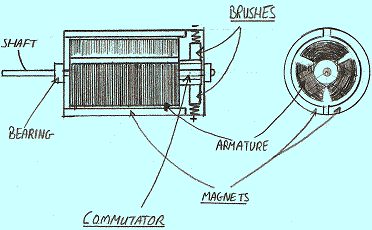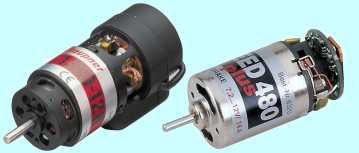|
Back to Electrical
Index
|
|
ELECTRICKERY
|
|
Motors used in model boats are called DC
motors, i.e. the motor rotates when a Direct Current is applied. You
don't need to know the "WHY'S and WHEREFORE'S",
just take my word for it. Batteries supply Direct Current
and so are the most suitable power source.
DC motors have permanent magnets and a
central rotor called an armature. When the current
is supplied to the armature, it produces an
electro/magnetic field which reacts within the
permanent magnet's field causing the armature to spin. DC
motors are designed to spin faster and more
efficiently in one direction, usually
anti-clockwise looking from the output shaft end. You can run
these motors in two different modes. Mode 1) Motor run at maximum
efficiency which is optimum speed or torque for
the minimum current consumption. Mode 2) Motor run at
maximum possible speed within the motors current limit.
Mode 1 is for "scale" boats and mode 2 is for the speed
merchants. There you are, a complete physics lesson in two minutes.
|
|

There are two basic types of DC motors, 'slow' ones and 'fast' ones,
I'm not going too fast for you am I? Both types may appear identical
but the internal construction and set-up will determine it's speed
but all DC motors use the same basic components. Slow
motors are used in scale boats, tugs, merchant ships, warships etc, any
boat that is required to run at a relatively low speed. These slow
motors commonly have low current consumption which enables them to run
for a long time from each battery charge. What they lack in RPM they
make up for in torque, they can propel large boats, drive multiple
prop shafts and can turn large propellers. A larger propeller is
usually more efficient than a smaller one but requires more torque to
turn it. A reduction gearbox will reduce RPM from any motor but increase
it's torque. This applies to slow and fast electric motors and IC
engines so reduction gears are not uncommon in model boats. |
|
Size of a motor is commonly an indication of it's output power but not
of it's speed. There are all sorts of numbers associated with the
size of model motors, eg. 380, 540, 550, 750, which are Macbuchi
numbers, probably the worlds largest producer of electric motors. (For
more details on these motors, see 'The power game' RCMB Nov/Dec
1992). Motors can also have names such as Milliperm, Monoperm,
Decaperm and Hectoperm, these are high quality and high priced slow
motors. Other terms connected with motors are poles and windings which
refers to how the armature is constructed. Of course you can also use
electric motors from other sources such as video recorders, tape decks,
computer equipment, car heaters etc, even from an aeroplane wing in one
case! These motors are usually chosen because the builders availability
to them. With these motors you will obviously be on your own when it
come to testing them for suitability. You can use any sort of
electric motor to power your boat but if in doubt all boat kits give a
recommended motor names or sizes. |
|
Back to Electrical
Index
|
|
FAST
MOTORS! |
|
 |
|
A fast boat requires a fast high revving motor. Some of
these motors can be really fast, 50,000 RPM (yes fifty thousand) and
handle up to 100 Amps. These motors can break world records as well as
your bank account. But unless you are using an efficient prop and
running gear (the motor, couplings & shafts etc.) you could be wasting a
lot of that RPM and power. We'll come back to this when talking
about installation and upgrading. There are number of really high
power fast motors such as Ultra, Astro, Keller & Hecktoplett, these
are specialist motors used by people that just want out-&-speed. Most
sports boats kits use 540, 550 and 750 sized motors or SPEED 500, 600
& 700 motors according to GRAUPNER numbering. The range of fast motors
is staggering and choosing the "right" fast motors is a highly debated
subject. I've used a number of fast motors and personally I like
the Robbe EF 76 II, Graupner 7022 and the Graupner SPEED 700 BB TURBO.
The first two are 550 sized and the third a 750. You will see these
motors and others used in various kits over the following months. These
motors are from the cheaper end of the market but are good enough for
most sports boats and club racing. |
|
Which motor you choose to use is not the most important
consideration however, the motor / running gear alignment is much more
crucial. In every case the motor to prop shaft or shafts MUST line
up perfectly. Good alignment will mean less load on the motor
therefore less current drain and enabling higher speeds. Bad
alignment could damage the motor and running gear bearings, overload
the speed controller or just shake the boat to pieces. What you are
trying to achieve is a perfectly straight continuation of the motor
shaft down through the coupling and prop shaft to the propeller. Use a
longer prop shaft and a solid sleeve to check that shafts meet parallel
and dead centre. Alignment is purely a matter of the builders
skill but even a novice can do a good job if he takes the time to get it
right. While installing or generally working on your boat, it's an idea
to tape up the motor's vent holes to prevent the ingress of dust and
dirt.
|
|
In direct drive boats, i.e. motor in-line with a solid prop shaft,
some sort of flexible or universal coupling must be used to join the
motor to shaft. The coupling compensates for any slight changes in
alignment that occur as the motor load varies. There are lots of
different types of coupling but the plastic and brass HUCO or RIPMAX
couplings are the most popular and provide good service. If you buy a
straight middle section for this type of coupling and install the motor
and shaft around this "solid" coupling, (swapping it for the jointed
type when complete) this will make for 'straighter' alignment. The
exception to this rule is 1) the flexi shaft were you must use a solid
coupling to prevent the shaft whipping and 2) when using a gear
reduction in which case the gears provide the shaft alignment. In all
cases the running gear should always be very free turning and very
quiet. If it's easy to turn the running gear in your fingers and it
makes hardly any noise, it indicates a good installation. Always check
that the coupling is secure before running your boat. If it's seems to
wearing quickly during the boats life your alignment is out and needs to
be corrected, a coupling "should" never wear out in most normal
situations. |
|
The motors need SMALL drop of oil on the shaft bearings from time to
time. The armature's copper commutator also needs cleaning, model
shops sell cleaning sticks for this which makes the job easier. Most low
cost 540 and 550 motors have sealed cans so cleaning or replacing
worn brushes is difficult if not impossible, try meths on a cotton
bud through the side cooling slots and turn over by hand. Of course
you can completely strip down and overhaul a motor, but only if you've
got a major problem. I've read in several publications that motors must
never be washed out with any sort of spray but there are a number of
reputable motor cleaner sprays on sale in model shops so make your own
choice but if water does splash into your motor, you will need to wash
it out and lubricate it with something. For more information on
electric motors, read any of the model car magazines which often
feature such matters.
|
|
Bad 540 Motors!!



These are pictures of the
rogue 550 fan-cooled motors which have caused several members some grief
over the last year. They are available on E-Bay as well as at shows and
from certain retailers. The legend on the can says simply “Johnson”; there
is no further ID except the numbers around the flux rings (which mean
nothing to me). These are three-pole motors with an internal plastic
cooling fan which can be seen through the slots in the case just in front
of the brushes. The backplate is a dark grey metal casting as opposed to
the usual 540-style white plastic moulding or silver-coloured steel
pressing. The case is substantially longer than a stock 540 – some 65mm
from end to end, and the motors have two steel flux rings pressed around
the forward half of the case.
We have found that the motors are not suitable for “normal” scale models
if run at anything over 6 volts. For example, one member has two of these
things fitted into a Graemsay ferry and has discovered that he has “low
speed handling difficulties running from 12 volts” – probably the
understatement of 2006. Another member reports that the stalling current
is astronomical and I can personally vouch for the high current
consumption, even at relatively low speed on 7.2 volts. They also get very
hot very quickly and should be water-cooled for all installations.
In short I wouldn’t recommend anyone to buy one of these unless they are
very familiar with all aspects of operating high-speed DC motors. Indeed,
the only reason I have one to photograph is that it was given to me.
Personally I wouldn’t install it in anything but a wheelie bin………but
what do I know! |
|
ALL ELECTRICAL MOTORS,
REGARDLESS OF SIZE WILL NEED TO BE FITTED WITH SOME SORT OF ELECTRICAL
SUPPRESSION TO PREVENT RADIO INTERFERENCE...
Click over to
FAST ELECTRICALS
http://ann-neil.supanet.com/caps.pdf
Well
all of this is just my opinion, but what the hell do I know!
|
|
Back to Electrical
Index
HOME
|




